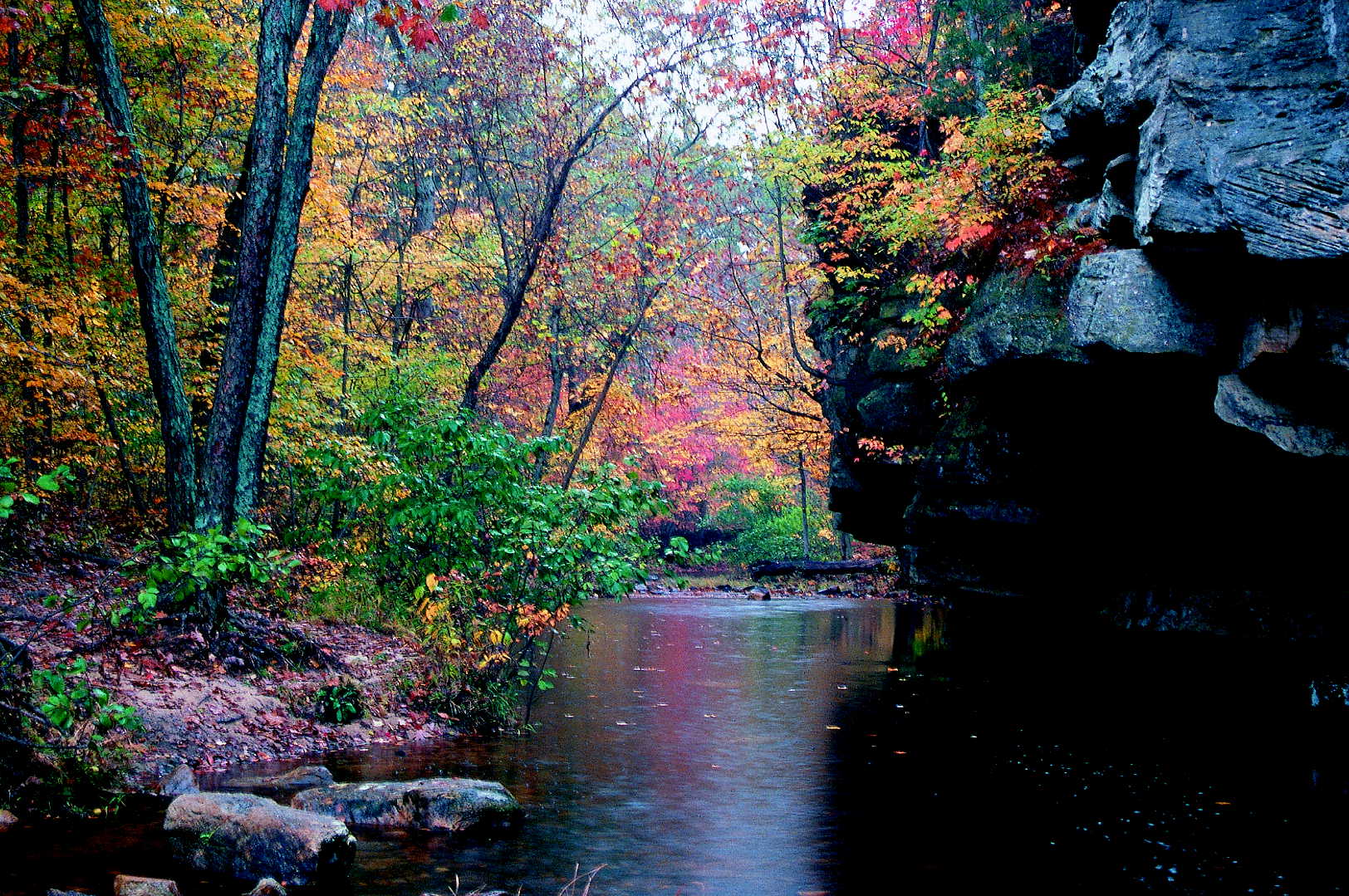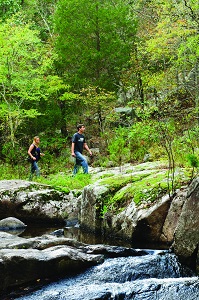at Hawn State Park
Wonders of Nature

For someone seeking scenic landscapes, outstanding vistas and dramatic windows on nature, Hawn State Park is the place to visit. The park is located in an area of the state where exposures of distinctive Lamotte sandstone bedrock create an unusual landscape with rounded sandstone knobs, canyon-rimmed valleys and vertical cliffs above clear, sandy-bottom streams. The sandstone’s unique ability to hold groundwater produces a concentration of rare and unusual plants in this region.
The acidic soil that has formed over this ancient sandstone supports upland woodlands of tall, straight shortleaf pine, Missouri’s only native pine tree. Mixed in with the pine trees are hardwood trees such as white oak, shagbark hickory and red maple. In the spring, the park abounds in color from the delicate pink and white flowers of the wild azaleas that thrive in the acidic soil. Because of the sandstone influence, many of the park’s 660 species of trees, shrubs, ferns and wildflowers can be found only in this area of the state.
Much of the park is in Whispering Pine Wild Area, a large tract set aside as wilderness and offering excellent opportunities for solitude, hiking, backpacking, bird watching and nature study. The majority of the wild area is covered with shortleaf pine, white oak, black oak and flowering dogwood. Wildlife abounds with turkey, white-tailed deer, raccoon, eastern gray squirrel and broadheaded skink.
The influence of the sandstone also can be seen in Pickle Creek and the River Aux Vases, which meander across the landscape, carving steep-sided valleys. In some places, the water cuts deep enough to reach the igneous rock, forming spectacular shut-ins. In several areas, sandstone overhangs along the streams create a cooler atmosphere with nearly constant shade and moisture. Here, plants like rattlesnake orchid, hay-scented fern, partridge berry and ground pine, normally found in northern Missouri, thrive.
More than 20 species of native fish, including rainbow darter, striped shiner and silverjaw minnow, swim in the cool waters of Pickle Creek Natural Area. Pickle Creek winds its way for 2 miles through narrow and scenic sandstone valleys. The stream rushes over granite outcrops and shut-ins as well as sandstone and a banded crystalline rock that some geologists believe is a metamorphic gneiss rock. It is one of the few places in the state where such a diversity of rocks is exposed at the surface. The forests and woodlands along Pickle Creek are dominated by white oak, shortleaf pine and scarlet oak with flowering dogwood and low bush blueberry in the understory. The area supports an abundance of mosses, lichens and ferns such as cinnamon fern and royal fern. Because of Pickle Creek’s high quality and pristine nature, it has been designated an Outstanding State Resource Water.
 The park also includes Botkins Pine Woods Natural Area, which features pure stands of shortleaf pine at the head of coves and on side slopes. The stand of mature shortleaf pines reach up to 80-90 feet and make the perfect place to look and listen for pine warblers in the spring and red-breasted nuthatches in the winter. LaMotte Sandstone Barrens Natural Area features sandstone glades and a dry sandstone forest characterized by shortleaf pine. Wildflowers that have adapted to living on the hot, dry conditions of the glade include lance-leaved coreopsis and yellow star grass.
The park also includes Botkins Pine Woods Natural Area, which features pure stands of shortleaf pine at the head of coves and on side slopes. The stand of mature shortleaf pines reach up to 80-90 feet and make the perfect place to look and listen for pine warblers in the spring and red-breasted nuthatches in the winter. LaMotte Sandstone Barrens Natural Area features sandstone glades and a dry sandstone forest characterized by shortleaf pine. Wildflowers that have adapted to living on the hot, dry conditions of the glade include lance-leaved coreopsis and yellow star grass.
Because of the diversity of birds and the habitat it provides for the birds, the park is recognized as an Important Bird Area with the National Audubon Society. This global bird conservation program is designed to identify, monitor and protect landscapes most important to birds. The recognition acknowledges the global significance of Hawn State Park in the conservation of bird populations. The park’s varied landscapes provide homes to birds such as pine warblers, chickadees, owls, scarlet tanagers, blue-gray gnatcatcher, white-breasted nuthatch, black-and-white warbler, Louisiana waterthrush and northern parula.
The best way to experience Hawn State Park is to hike its trails. The park’s five trails vary in length and experiences offered. They range from a short trail that serves as an excellent introduction to the park to Whispering Pine Trail, considered one of the best hiking and backpacking trails in the state.






